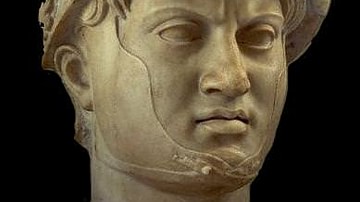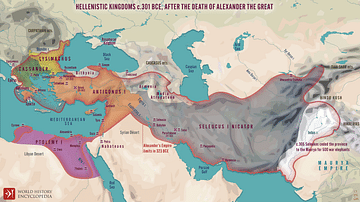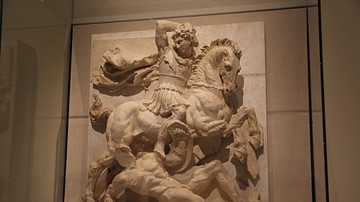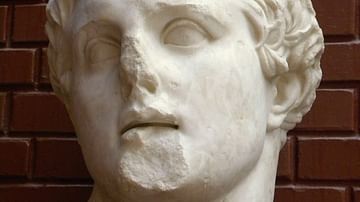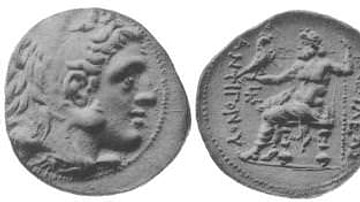EDIT TEST
To call Polybius our best guide to Hellenistic history might be misleading for a few reasons. Firstly, Polybius' Histories are by no means perfect; for a start, as they have come down to us they are incomplete. To term it 'the best' implies all sorts of qualities, which his Histories might not necessarily possess, such as being the most accurate, objective, detailed and broadest source of the period. In certain, perhaps more specific areas, material evidence might provide the best guide to certain aspects of Hellenic history: numismatics and sculpture, whilst other literature, such as poetry and other histories might complement Polybius. Furthermore there is the stupendous amount of detail which can be gleaned from the copious amounts of epigraphic and fragmentary accounts of the period, which can cover all aspects of Hellenistic culture. Secondly, what do we term Hellenistic history? The Hellenistic period ranged from Alexander the Great to Augustus (336 BC- 14 AD), a period of some 350 years. The history of this period is therefore Hellenistic, and history is a very broad term which can refer to the politics, wars, geography, ethnography, culture and countless other aspects of 'past events'. However, since Polybius' Histories covers just 118 years out of those 350 (from 264- 146 BC) there is a slight problem in calling him our best guide because he doesn't so much as cover even half of the Hellenistic period; a happy medium would be to call him the best guide that we have to the period which he covers.
Why then is Polybius the best guide to the period? Another factor which makes Polybius superior is the quality of his writing, the accuracy and factuality of it and its objectivity. Polybius states that “once a man takes up the role of historian he must discard all considerations of this kind [biases towards friends and country]… he will often have to have to speak well of his enemies…” (Polybius i.14 (all translations are from the Penguin edition; trans. Ian Scott-Kilvert, intro. F.W. Walbank, unless stated otherwise)) and he can be seen enacting this sentiment at i.64, when Polybius says of Hamilcar that he is “… the general who must be acknowledged as the greatest on either side, both in daring and in genius…”. Another factor that contributes to Polybius' hegemony of Hellenistic history is that he was a contemporary historian, and he himself saw this as an important factor. Xvi.14- 20 is a brilliant passage, and here I shall use it to show how Polybius uses the contemporary nature of an historian as a selection factor; he mentions Zeno and Antisthenes of Rhodes as “worthy of commemoration and full discussion” because they were contemporary with the events (this idea of being contemporary is also linked to that of experiencing things first-hand, Polybius' strong opinions on this matter can be seen at xii.28a, where he effectively berates Timaeus), as well as being “engaged in practical politics; and, lastly, they composed their histories with no view to gain, but for the sake of fame, and as part of the business of politicians”.
However, as iii.9 shows, being contemporary is not always synonymous with being accurate (“they look to the fact that Fabius was a contemporary of Hannibal… and immediately believe that everything he says must be trusted”), and as such to what extent are the other factors that Polybius gives to good historians (and presumably himself!): xvi.14 presents a few more, to be “engaged in practical politics” and to compose “histories with no view to gain” (perseus.tufts.edu). These factors (Polybius' objectivity, the accuracy of his work due to his contemporary nature, and his criticisms of other Historians) alone make Polybius a very authoritative guide to the period as well as the meticulous nature of his methods as seen at a passage such as xii 4c; “…to question as many people as possible, to believe such witnesses as are trustworthy, and to prove him [the historian] a good judge of the reports that reach him”. However, is Polybius the best guide by default? How can we justify arguing that Polybius is better than Xeno, Antisthenes, or Fabius, or for that matter Timaeus, who Polybius criticises at great length in book xii over his inaccuracies about Sardinia and Italy, examples of which have not survived (Scott-Kilvert, I. trans. 1979. Polybius, The Rise of Roman Empire. Penguin, London. pp. 431)?
There is a certain amount of irony to think that tuxh, one of the greatest themes present throughout Polybius' Histories, is the main reason that his work survived Note, if we don't have their works to re-evaluate and analyse for ourselvesNote, and hence why he is seen as the best Historian of the period. But, as covered above, we have enough of what Polybius says of other historians and 'monograph writers' (“kata meroj”: Sacks, K. 1981. Polybius on the writing of History. University of California Publications in Classical Studies, California. pp. 99ff.) to suggest that they were worse anyhow; however, to a certain extent, Polybius would say that.
Nevertheless, Polybius, on occasion, is willing to admit that others might be better than him. Back to Zeno and Atisthenes; Polybius says that “from the reputation of their country, and the idea that naval affairs are peculiarly the province of Rhodians, some students may prefer their authority to mine where I differ from them” (Polybius; xvi.14- perseus.tufts.edu). As well as this Polybius concludes this passage on Zeno with an admission that “I would beg my own readers, whether of my own or future generations, if I am ever detected in making a deliberate misstatement, and disregarding truth in any part of my history, to criticise me unmercifully; but if I do so from lack of information, to make allowances” (Polybius; xvi.20- perseus.tufts.edu). Therefore Polybius allows the possibility that he might have made errors of this kind, and modern critics would argue that he has, most noticeably with regards to Aetolia (De Laix, R.A. 1969. Polybius' Credibility and the Triple Alliance of 230/ 299 BC. California Studies in Classical Antiquity, 2, pp. 65- 83 & Champion, C.B. Polybius and Aetolia: A Historiographical Approach. In Marincola, J ed. 2011. A Companion to Greek and Roman Historiography. Wiley-Blackwell, London. pp. 356- 362) or the way in which he never seems to show Rome as the aggressor (Walbank, F.W. 1990. Polybius. University of California Press, London. pp. 164). It is important to remember that whilst Polybius might have a monopoly on Hellenistic history, he certainly is not infallible.
However, if there were ever a contender to the title of best guide to Hellenistic history, other than Polybius, then it would be Diodorus Siculus (or perhaps maybe Ephorus, if he had survived) who wrote a world history centred on Rome, covering the legends of the known world and the history of it from the Trojan War through to Julius Caesar (Howatson, M.C. ed. 1989. The Oxford Companion to Classical Literature. Oxford University Press, Oxford, pp. 190). Whereas Diodorus is neither as technically accurate as Polybius (Green, P. Diodorus Siculus on the Third Sacred War. In Marincola, J ed. 2011. A Companion to Greek and Roman Historiography. Wiley-Blackwell, London. pp.363- 4), it is the fact that his history covers a greater period of time which makes him a possible contender to title of 'best guide'. For example, one aspect in Diodorus' favour is that his is the only surviving extended narrative on the third sacred war (Ibid. pp. 363- 378), but at the same time, one account does not make a guide to the period.
There are two main schools of thought on Diodorus, those who see his text as 'cannibalised' (Sacks, K.S. 1990. Diodorus Siculus and the First Century. Princeton University Press, Oxford, pp. 4), and those who see it as a document showing the political and intellectual attitudes of the time (Ibid, pp. 5), as expressed by Diodorus himself (i.e. one school berates Diodorus, the other gives him more credit), but both would be willing (mostly) to term him a 'second class' historian (Green, P. Diodorus Siculus on the Third Sacred War. In Marincola, J ed. 2011. A Companion to Greek and Roman Historiography. Wiley-Blackwell, London. pp.363). However, this is generally from an historiographical point of view, and does not mean that Diodorus is any less useful as a guide to the period because of it: it is often through Diodorus that many lost sources of the period are preserved (Howatson, M.C. ed. 1989. The Oxford Companion to Classical Literature. Oxford University Press, Oxford, pp. 190) and as such this is used against him, showing his 'plagiarism' (Sacks, K.S. 1990. Diodorus Siculus and the First Century. Princeton University Press, Oxford, pp. 9), when perhaps it should be seen as a positive aspect which can be gleamed from is Histories. Nevertheless, the often contradictory nature of Diodorus' narrative makes it less than easy to follow (Green, P. Diodorus Siculus on the Third Sacred War. In Marincola, J ed. 2011. A Companion to Greek and Roman Historiography. Wiley-Blackwell, London. pp.363: “the chronology of the Third Sacred War… is highly confused”), and despite reasons being given in favour of Diodorus to explain these discrepancies (Ibid. pp.365- 378), they still remain, it is because of this that Polybius's work remains the better to act as a guide to Hellenistic history.
In contrast to the Historians and their history are the epigraphers and their epigrams. However, epigraphy is less of a continuing narrative, as Polybius' Histories are, but the various inscriptions offer 'snapshots' of various events, places, times, and people (McLean, B.H. 2002. An Introduction to Greek Epigraphy of the Hellenistic and Roman Periods from Alexander the Great down to the Reign of Constantine (323 B.C.- A.D. 337). The University of Michigan Press, Michigan, pp. 181- 214 + Roger S. Bagnall & Peter Derow. 1981. Greek Historical Documents: The Hellenistic Period. Scholars Press, Chicago), and they can often be very fragmentary, more so than the Historians' works (Ibid, pp. 65ff.). So in this sense they are not overly useful, used exclusively, as guides to the Hellenistic period; or at least as chronological guides. In contrast to this is the fact that epigraphic evidence does cover, near enough, all regions, and all timespans within the Hellenistic period. Grouped into certain categories, a collection of Hellenistic inscriptions would provide a very useful thematic guide to the period (Ibid. pp.182); however the problem with this (and more so with any attempted chronological groupings) is that it would be very disjointed in one way or another, and as such no single type of grouping will be suitable to all research (Ibid.), and hence a guide to Hellenistic history. One aspect in which epigraphy might be seen as better than Polybius' Histories is that whereas the reader is interpreting Polybius's own interpretations, with epigraphy we are forming more of our own conclusions by analysing the actual records and accounts of the time (we become the historian, as it were - i it would be nteresting to see what Polybius would have to say on this, considering his views on Timaeus in book XII ). However, this notion might be more strongly argued for in the context of analysing material evidence.
The Hellenistic Period offers up a vast wealth of material evidence. A study of Hellenistic king portraits can answer all sorts of questions; with regards to the influence of Alexander on later portraits we can see his continuing importance and influence; distinct and unusual features show how rulers played off realism against idealism to promote their images; and differences over time and (more so) location, can show the cultural influences of the various areas of occupation after the death of Alexander (cf. Plutarch, Alexander, 2.23 + 4.1; Pliny, N.H., 34.19.67; Lawrence, A. Greek Sculpture in Ptolemaic Egypt. The Journal of Egyptian Archaeology. 11, 179-190 (1925); Lehmann, P. A New Portrait of Demetrios Poliorketes. The J. Paul Getty Museum Journal. 8, 107-116 (1980); McLean, B.H. 2002. An introduction to Greek Epigraphy of the Hellenistic and Roman Periods from Alexander the Great down to the Reign of Constantine (323 B.C. – A.D. 337) University of Michigan Press; Pollitt, J. 1986. Art in the Hellenistic Age. Cambridge; Ridgway, B. 2001. Hellenistic Sculpture I, The Styles of ca. 331- 200 BC. Wisconsin; Smith, R. 1991. Hellenistic Sculpture. London; Smith, R. Three Hellenistic Rulers at the Getty. The J. Paul Getty Museum Journal. 14, 59- 78 (1986); Stanwick, P. A Royal Ptolemaic Bust in Alexandria. Journal of the American Research Center in Egypt. 29, 131-141 (1992)). However, the problem being once again that Hellenistic Sculpture would not be the best of guides to the Hellenistic period; it would be too narrow in the areas in which it informs us to be called that (without wishing to belittle the importance that sculpture has in terms of our understanding of the period), perhaps a better term to give it would be, “supplement to the Hellenistic period”. Likewise, numismatics is also more often linked to the study of specific rulers and cultural ideals such as that of the ruler cult.
Therefore we have a various set of categories (which are admittedly perhaps somewhat simplified) from which our best guide to the Hellenistic period could come from; either written (history, epigrams)- (McLean, B.H. 2002. An Introduction to Greek Epigraphy of the Hellenistic and Roman Periods from Alexander the Great down to the Reign of Constantine (323 B.C.- A.D. 337). The University of Michigan Press, Michigan, pp.65ff. epigrams are not just the text however, and are a cross over between literary and material evidence, since the monuments/ materials upon which they were inscribed also provide useful information, this is called Architectural Epigraphy, and is not discussed here) or material evidence (sculpture or numismatics). Whilst epigraphy, sculpture and numismatics are all greatly important to our understanding of Hellenistic culture, they do not provide the overarching narrative that a historical account does. As such they act as very important supplements to historical accounts, often adding interpretations and information which a history might not give, but they are not the best guides to the period, that title falls to the Histories of the period (by this I mean not just those concerning the Hellenistic period, but those written in the Hellenistic period), most notably, Polybius and Diodorus Siculus. And since we have already established how Polybius is a better historian than Diodorus, it seems logical to agree with the statement “Polybius is our best guide to Hellenistic History”. However, as also shown, Polybius is by no means perfect, and whilst he is our best guide to the Hellenistic period, he should not be our only guide, and he should be well supplemented, because, just from a chronological point of view, there is much that he doesn't cover.
BIBLIOGRAPHY
Burrow, J. 2009. A History of Histories. Penguin, London.
Champion, C.B. Polybius and Aetolia: A Historiographical Approach. In Marincola, J ed. 2011. A Companion to Greek and Roman Historiography. Wiley-Blackwell, London. pp. 356- 362
De Laix, R.A. 1969. Polybius' Credibility and the Triple Alliance of 230/ 299 BC. California Studies in Classical Antiquity, 2, pp. 65- 83
Green, P. Diodorus Siculus on the Third Sacred War. In Marincola, J ed. 2011. A Companion to Greek and Roman Historiography. Wiley-Blackwell, London. pp.363- 378
Howatson, M.C. ed. 1989. The Oxford Companion to Classical Literature. Oxford University Press, Oxford, pp. 190
Lawrence, A. Greek Sculpture in Ptolemaic Egypt. The Journal of Egyptian Archaeology. 11, 179-190 (1925)
Lehmann, P. A New Portrait of Demetrios Poliorketes. The J. Paul Getty Museum Journal. 8, 107-116 (1980)
McLean, B.H. 2002. An introduction to Greek Epigraphy of the Hellenistic and Roman Periods from Alexander the Great down to the Reign of Constantine (323 B.C. – A.D. 337) University of Michigan Press
Pollitt, J. 1986. Art in the Hellenistic Age. Cambridge
Ridgway, B. 2001. Hellenistic Sculpture I, The Styles of ca. 331- 200 BC. Wisconsin
Roger S. Bagnall & Peter Derow. 1981. Greek Historical Documents: The Hellenistic Period. Scholars Press, Chicago
Sacks, K.S. 1981. Polybius on the writing of History. University of California Publications in Classical Studies, California.
Sacks, K.S. 1990. Diodorus Siculus and the First Century. Princeton University Press, Oxford
Scott-Kilvert, I. trans. 1979. Polybius, The Rise of Roman Empire. Penguin, London. pp. 431
Smith, R. Three Hellenistic Rulers at the Getty. The J. Paul Getty Museum Journal. 14, 59- 78 (1986)
Smith, R. 1991. Hellenistic Sculpture. London
Stanwick, P. A Royal Ptolemaic Bust in Alexandria. Journal of the American
Research Center in Egypt. 29, 131-141 (1992)
Stoneman, R. “Books We Might Have Known”. Classical Association (2010)
Walbank, F.W. 1990. Polybius. University of California Press, London


